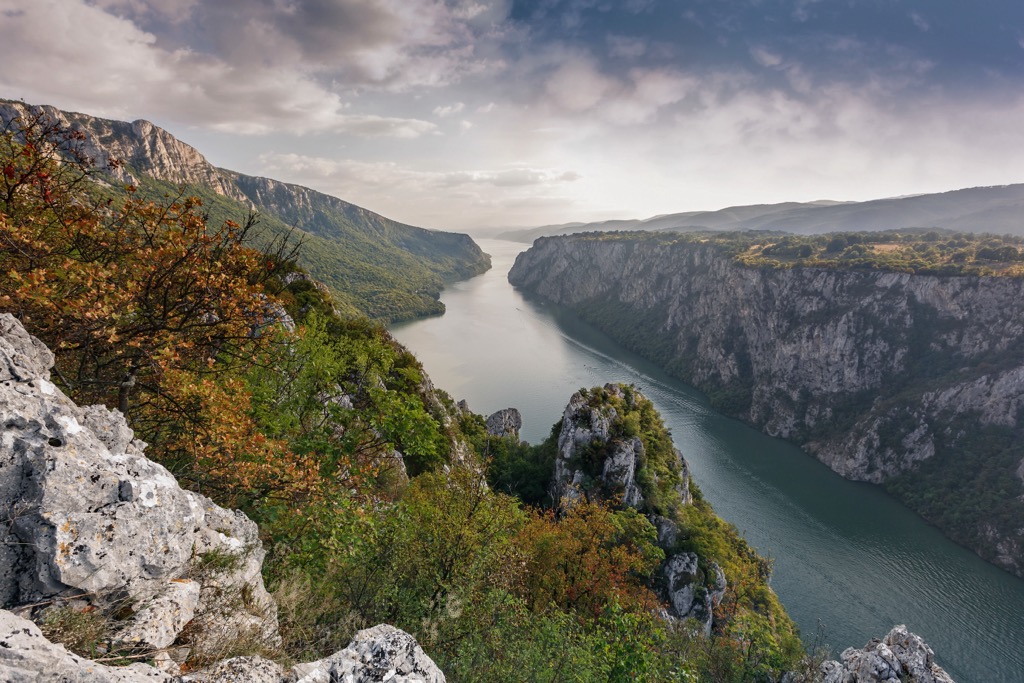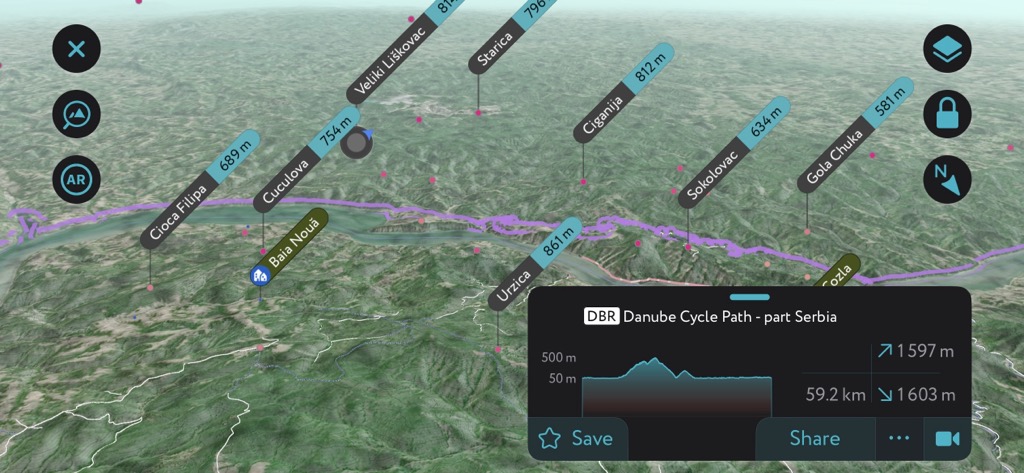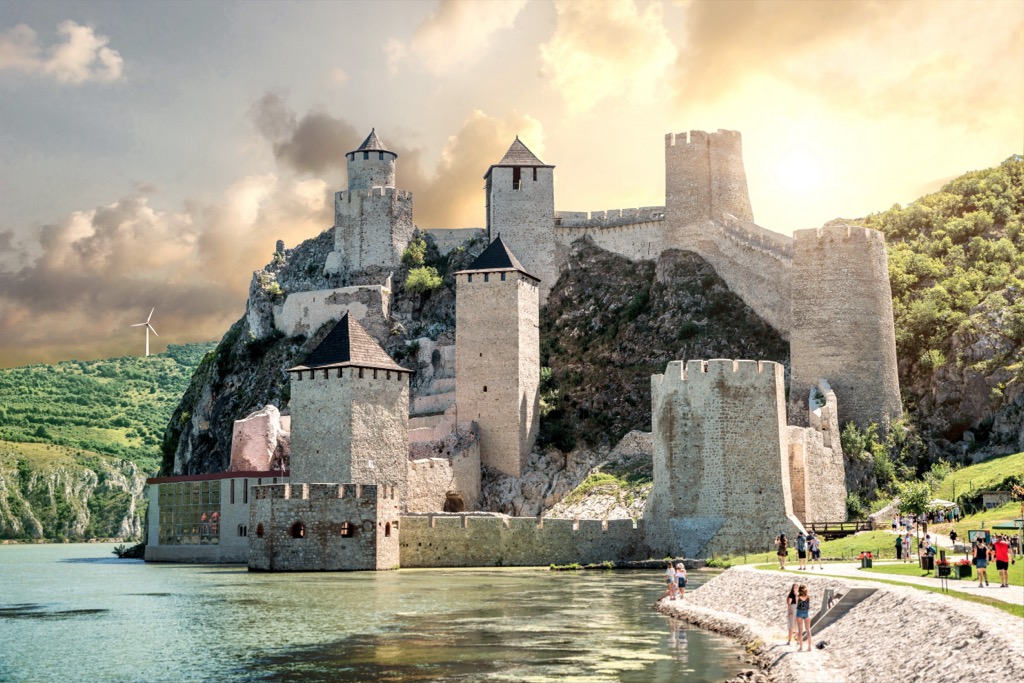Get PeakVisor App
Sign In
Search by GPS coordinates
- Latitude
- ° ' ''
- Longitude
- ° ' ''
- Units of Length
Share×

Scan the QR code and open PeakVisor on your phone
❤ Wishlist ×
Choose
Delete
Đerdap National Park showcases mountains, rivers, archaeology, and natural monuments in northeastern Serbia, on the border with Romania. There are 70 named peaks in Đerdap; Veliki Liškovac (814 m / 2,671 ft) is the highest and most prominent.

Đerdap National Park (also spelled Djerdap) spans along the right bank of the Danube River in Serbia, from Golubac Fortress to the dam near Novi Sip. It covers 63,786 ha (157,618 ar) and extends for 100 km (62 mi), featuring geological wonders, cultural monuments, and unique flora and fauna. The Danube River and the Iron Gate Gorge dominate the park. Just across the river is Romania's Iron Gate National Park.

In July 2020, the area around the national park earned the UNESCO global geopark designation, making it Serbia's first protected area with this label. In addition to the gorge, the geopark includes parts of the Miroč and Kučaj mountain massifs.
At the heart of Đerdap National Park lies the magnificent Đerdap Gorge (also known as the Iron Gate), Europe's longest and largest breakthrough gorge and a grand gateway through the southern Carpathian mountains.
Gospođin vir, one of the gorges of the Iron Gate, boasts one of the world's greatest river depths (82 m / 270 ft). The cliffs in Kazan reach about 300 m (984 ft) high, narrowing the river to 150 m (521 ft) wide.
The area now includes Lake Đerdap, a 253 sq. km (157 sq. mi) artificial lake formed by the construction of the Iron Gate I Hydroelectric Power Station, completed in 1972 and once the fourth-largest in the world.

Đerdap showcases diverse and stunning geology, ranging from the oldest Proterozoic rocks to the youngest Quaternary sediments. The mighty Danube has carved through the mountains, creating geological formations like gorges, caves, depressions, and springs.
The Djerdap Gorge consists of four smaller gorges and three valleys, each with distinct features. Deep whirlpools and giant potholes can exceed 80 m (262 ft) in depth, causing the Danube's riverbed to lie below sea level in certain areas.

Scenic viewpoints such as Veliki štrbac and Mali štrbac on Miroč offer vistas encompassing Deli Jovan and Veliki Krš mountains in Serbia and the Carpathians in Romania. The viewpoint Greben was hailed as the "most beautiful hill in the Balkans" by Jovan Žujović in 1900.
Blederija River originates from two karstic springs near the Topla Bara peak. The river cascades through a heavily forested area, culminating in the 8 m (26 ft) tall Blederija waterfall.

Đerdap is home to around 1,100 plant species, including Tertiary relics like Turkish hazel, walnut tree, European yew, largeleaf linden, downy oak, and European holly. Notably, the Djerdap tulip (Tulipa hungarica borbás) was extirpated from the region after the reservoir flooded its riparian habitat. The species still exists in other riparian zones in central Europe.
Among the 15 Balkan-specific species are Pančić's maple and certain species of heartsease, wild thyme, and meadow fescue. Carpathian endemites like sweet carrot and Seseli rigidum are also present, along with internationally protected species like floating fern, Fritillaria degeniana, water caltrop, Bulbophyllum loroglossum, and cat grass.

The park is home to 150 bird species. In December 2018, Dalmatian pelicans were spotted, marking their return after over a century. The wider park area also supports other rare or previously extinct species, such as nesting couples of white-winged terns and the second nesting locality of yellow-legged gulls in Serbia.
Other birds include the European roller, woodchat shrike, booted eagle, common tern, and greylag goose. As of the 2020s, Djerdap maintains a stable population of 10 to 12 Eurasian lynx, contributing to the estimated 40 to 60 in Serbia.

This park features evidence from prehistory, the Roman Empire, and the Middle Ages. Over more than ten millennia, this area's cultural landscape has continuously changed.

Both Đerdap and its former Serbian name, Demir-kapija, have Turkish origins. Demir-kapija, meaning "iron gate," was used in different languages as the name of the gorge. Đerdap comes from girdap, meaning whirlpool or vortex.
The national park is filled with natural and cultural values under special protection. Lepenski Vir, an archaeological site dating back 11,500 years, reveals essential traces of Mesolithic and Neolithic settlements.

The region played a role in the transit routes of Triballi, Dacians, Autariates, and Romans. The famed Trajan's Bridge, built in 105 AD, and the Roman fortress Diana in Kladovo are among the historical remnants. The Golubac fortress is a significant medieval monument, showcasing artifacts like pottery, iron tools, and a memorial drinking fountain dedicated to Zawisza the Black.
The gorge is replete with myths, including one about a devil-faced midget in the Danube's whirlpools and another about a gigantic sturgeon called "beluga." Unfortunately, some historical sites were submerged by the artificial lake. However, remnants like Trajan's Plaque, the Castrum Diana, and impressive fortresses like Golubac and Fetislam still testify to the Roman Empire's strength. Additionally, urban heritage is evident in Kladovo, with traditional architecture and folk traditions.


The Mali Štrbac hike is a 7 km (4.3 mi) trail commencing at Golo Brdo along Djerdap state road 35. The path starts at 254 m (833 ft) above sea level and winds through the Djerdap National Park's forests, culminating at the Mali Štrbac viewpoint at 626 m (2,053 ft).
From there, you can continue to Ploče, passing three additional viewpoints, before descending through the forest trail to Djerdap State Road 35 or retracing your steps back to Golo Brdo.
One of Djerdap National Park's most enchanting viewpoints is the Veliki Štrbac. The hike covers 7.6 km (4.7 mi) at a moderate difficulty rating. The primary trail begins at Pecka Bara and climbs to the highest peak of Miroč mountain at 768 m (2,519 ft). However, the protected area surrounding Veliki Štrbac and Mali Štrbac is accessible through various routes, so plenty of options exist.
Veliki Štrbac offers a breathtaking panorama of the Danube in its narrowest stretch and the dramatic gorge of Djerdap Kazan.
The easy 1.6 km (1 mi) Boljetinska Reka Gorge trail is the first protected geological site in the Djerdap region. With a gentle slope, the path unveils the geological wonders shaped by Boljetinska Reka's incision in sedimentary rocks along a fault.
Visitors can explore sediment layers dating back around 160 to 145 million years, remnants of the ancient Tethys Ocean. Fossilized remains of various cephalopods, such as ammonites and belemnites, provide a glimpse into the ocean's inhabitants from millions of years ago.
Belgrade is a dynamic metropolis experiencing rapid growth and exuding a rich blend of diversity and culture. Serbia's vibrant capital and largest city boasts a population of approximately 1.3 million. As the country's economic hub, it’s home to economic sectors such as industry, trade, transport, communications, and tourism.
With a history that intertwines with various epochs, including Ottoman rule, the city holds a complex narrative. The architectural landscape is a mosaic of styles, reflecting its multifaceted past and offering a spectrum of colorful options that distinguish it from other urban centers.

Serbia's second-largest city is a cultural and economic hub located in the northern part of the country. With a population of about 300,000, it is a center for commerce, education, and arts, making it a significant player in Serbia's development.
Novi Sad is a city that thrives on its cultural richness and economic vitality. Steeped in history, it showcases a blend of architectural styles reflecting its diverse past, from Austro-Hungarian influences to more contemporary elements.

With a population of around 15,000, Majdanpek is known for resource extraction, with an enormous copper mine. The town mostly consists of apartment buildings for mining workers, though it also offers affordable mountain access. Nevertheless, there are many more exciting places to stay in Serbia.

Explore Đerdap National Park with the PeakVisor 3D Map and identify its summits.








